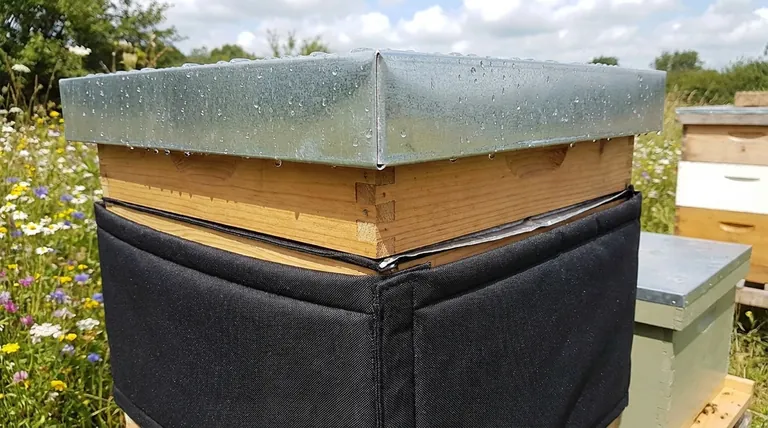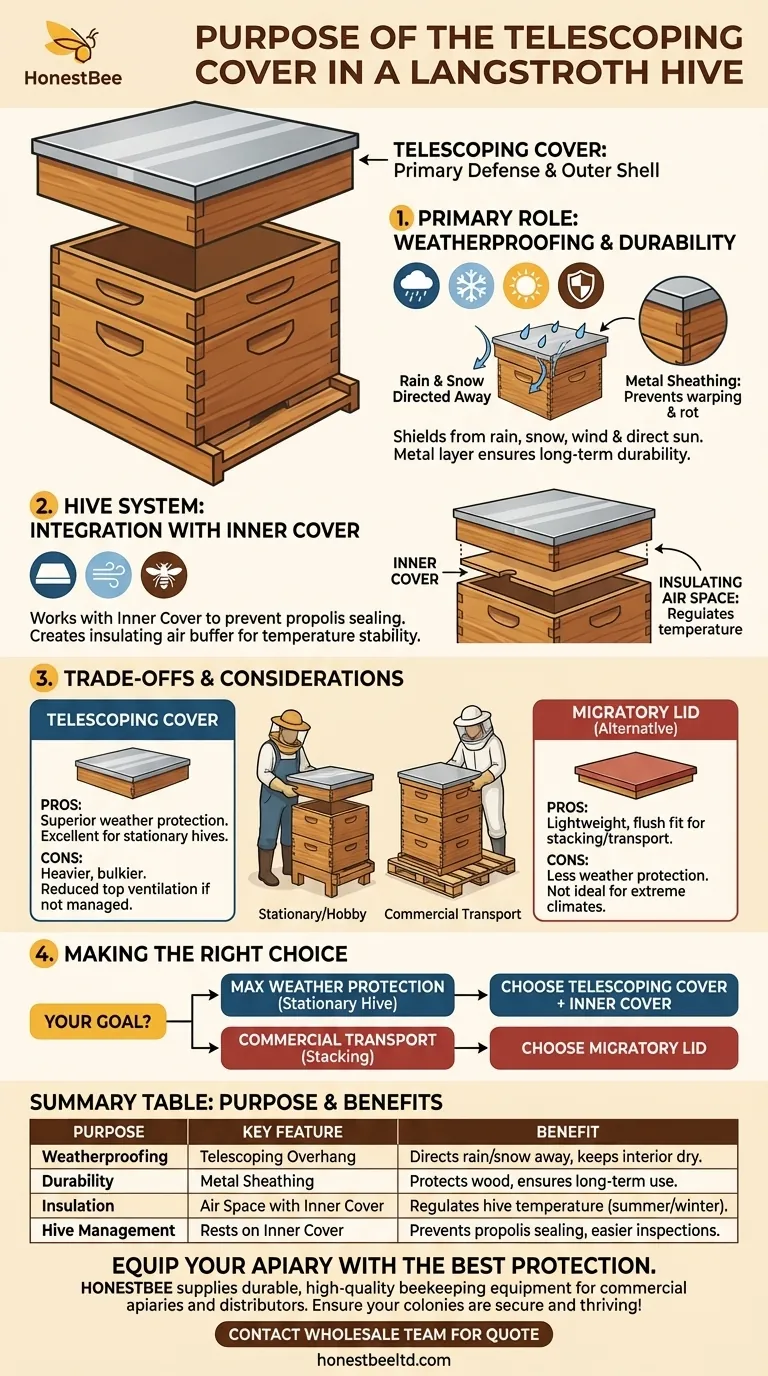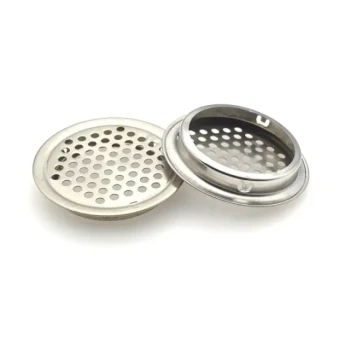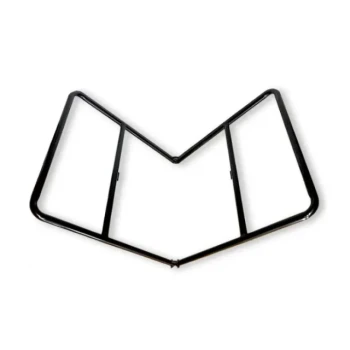In essence, the telescoping cover is a Langstroth hive's primary defense against the weather. Its defining feature is its "telescoping" design, meaning it overhangs the top hive body like the lid on a shoebox, providing superior protection from rain, snow, and sun.
The telescoping cover is more than just a lid; it's the outer shell of a two-part roofing system. It works in tandem with the inner cover to provide maximum weather protection, insulation, and easier hive management by preventing the bees from gluing the roof shut.

The Primary Role: Weatherproofing the Hive
The most fundamental purpose of the telescoping cover is to create a durable, weatherproof shield for the entire colony.
Shielding from Rain and Snow
The cover's sides extend down over the top edges of the uppermost hive box. This overhang ensures that rain and melting snow are directed away from the hive's joints, preventing water from seeping inside.
A dry interior is critical for the colony's health, especially during winter.
Metal Sheathing for Durability
Most telescoping covers are sheathed in a sheet of aluminum or galvanized steel. This metal layer protects the wooden cover from the elements, preventing it from warping, cracking, or rotting over time.
This ensures the hive remains sealed and secure for many years.
Blocking Wind and Sun
By fitting securely over the hive, the cover blocks harsh winds and direct sun. This helps the colony maintain a stable internal temperature, reducing the energy they must expend on heating or cooling the hive.
How It Fits into the Hive System
The telescoping cover's design is brilliant because it doesn't work in isolation. Its function is unlocked by its interaction with the inner cover.
The Critical Relationship with the Inner Cover
A beekeeper rarely places the telescoping cover directly onto the frames. It rests on top of the inner cover.
This is crucial because it prevents the bees from sealing the telescoping cover to the hive bodies with propolis (a sticky resin). Without an inner cover, prying the roof off for an inspection would be extremely difficult and disruptive to the colony.
Creating an Insulating Air Space
The inner cover creates a pocket of dead air between itself and the telescoping cover. This air space acts as a layer of insulation, protecting the colony from extreme summer heat and winter cold.
The telescoping cover seals this insulating buffer from the outside world.
Understanding the Trade-offs
While the standard for hobbyists, the telescoping cover is not the only option, and it has specific characteristics to consider.
Weight and Handling
Telescoping covers are heavier and bulkier than simpler "migratory" lids. This can make them slightly more cumbersome to lift during hive inspections.
Reduced Top Ventilation
The snug fit, which is excellent for weather protection, can sometimes trap moisture if not managed correctly. This is why the inner cover is so important, as its notched rim can be used to provide upper ventilation or an entrance.
Not Ideal for Commercial Transport
Commercial beekeepers who move thousands of hives often prefer flat, migratory-style lids. These lids sit flush with the hive body, allowing hives to be stacked tightly together on pallets for transport, a feature the telescoping cover's overhang prevents.
Making the Right Choice for Your Apiary
The decision between a telescoping cover and a simpler lid depends entirely on your beekeeping goals and climate.
- If your primary focus is maximum weather protection: The telescoping cover, paired with an inner cover, is the superior choice for a stationary hive in almost any climate.
- If your primary focus is commercial-scale beekeeping: A migratory lid is more practical for stacking and transporting hives in large numbers.
- If your primary focus is hive health: Always use the telescoping cover in conjunction with an inner cover to balance premier protection with proper ventilation and ease of inspection.
Ultimately, providing your bees with a dry and secure home is a fundamental part of responsible beekeeping.
Summary Table:
| Purpose | Key Feature | Benefit |
|---|---|---|
| Weatherproofing | Telescoping overhang design | Directs rain/snow away, keeping the hive interior dry. |
| Durability | Metal sheathing (aluminum/galvanized steel) | Protects wood from warping and rotting for long-term use. |
| Insulation | Creates an air space with the inner cover | Helps regulate hive temperature in summer heat and winter cold. |
| Hive Management | Rests on an inner cover | Prevents bees from gluing the roof shut, making inspections easier. |
Equip your apiary with the best protection. The telescoping cover is a cornerstone of a healthy, productive hive. At HONESTBEE, we supply durable, high-quality beekeeping supplies and equipment designed for the needs of commercial apiaries and beekeeping equipment distributors. Ensure your colonies are secure and thriving—contact our wholesale team today to discuss your needs and request a quote!
Visual Guide

Related Products
- Professional Insulated Winter Hive Wrap for Beekeeping
- Inner Beehive Cover for Beekeeping Bee Hive Inner Cover
- Endless Loop Ratchet Hive Strap
- Wholesales Dadant Size Wooden Bee Hives for Beekeeping
- Professional Insulated Plastic Bee Hives
People Also Ask
- How does insulation help bee hives in severely cold weather? Conserve Energy & Ensure Colony Survival
- What is the advantage of an insulated outer cover? Boost Winter Survival & Spring Buildup
- What factors ensure bees stay warm and healthy during winter? Master the 3 Keys to Hive Survival
- Is it always necessary to insulate beehives? A Guide to Winter Survival & Colony Health
- Why is it important to insulate beehives during winter? Boost Your Colony's Survival Rate



















